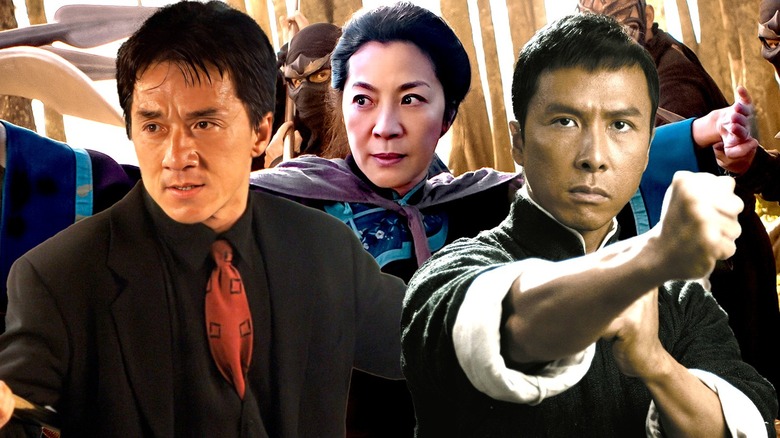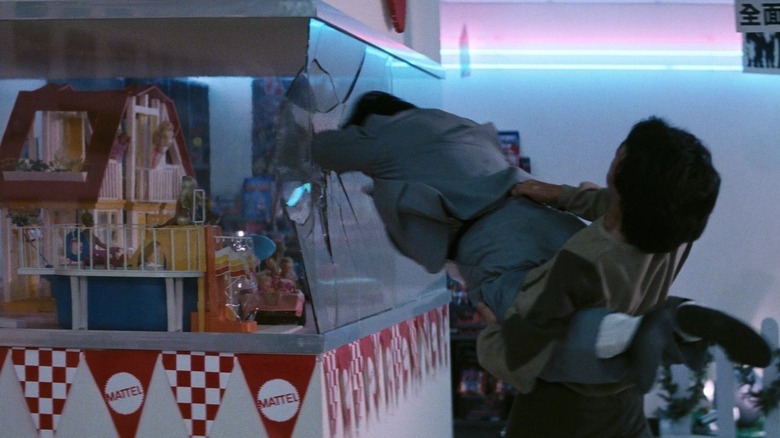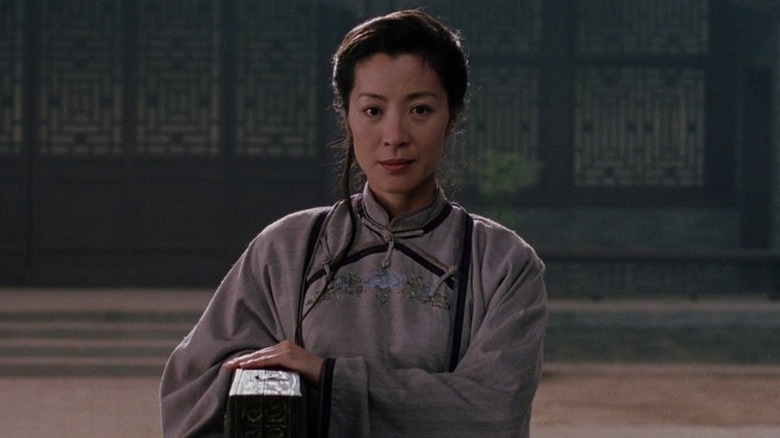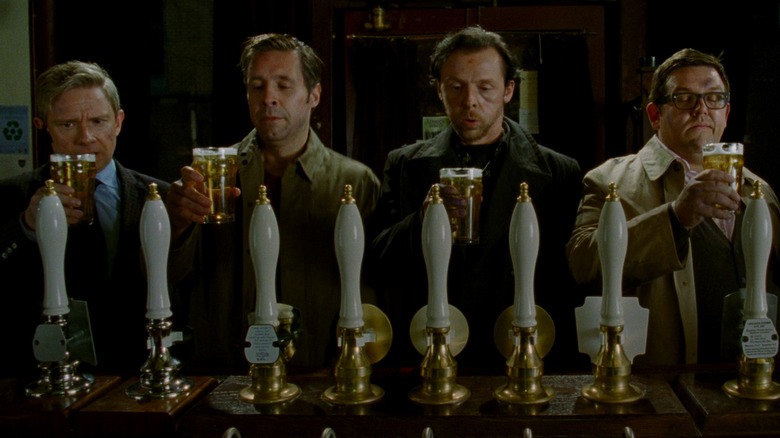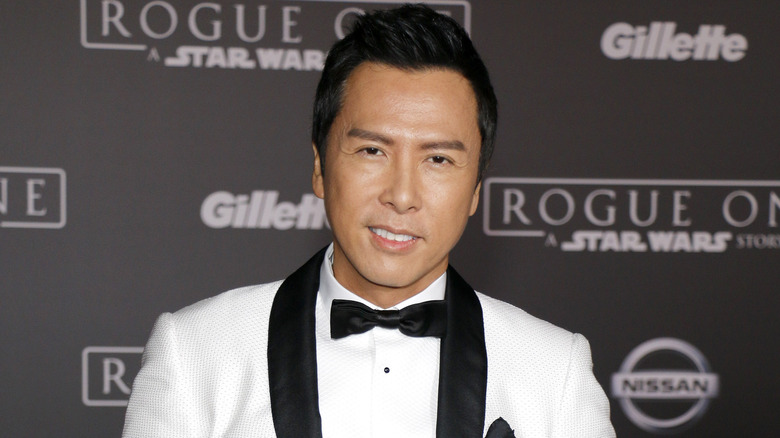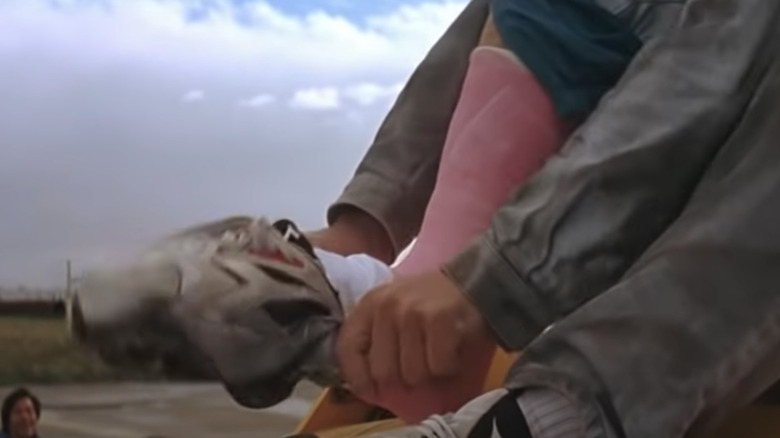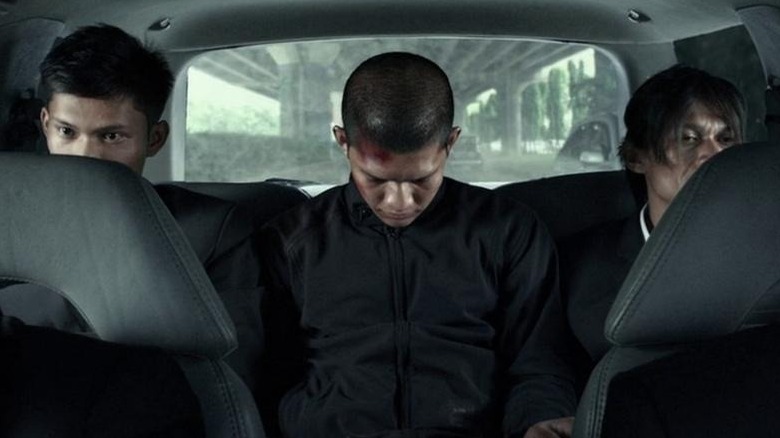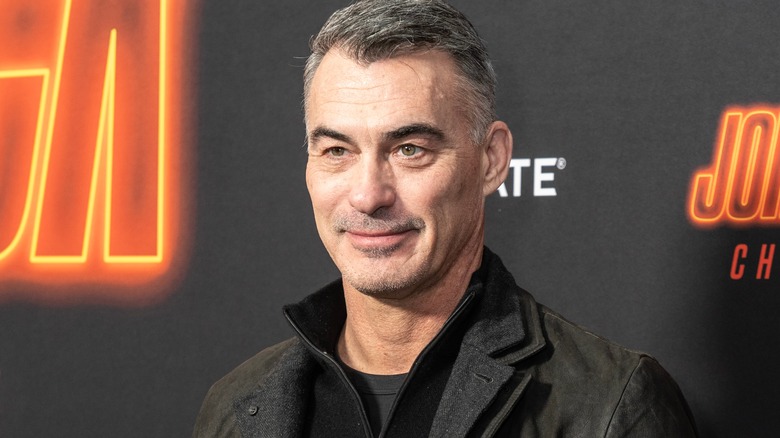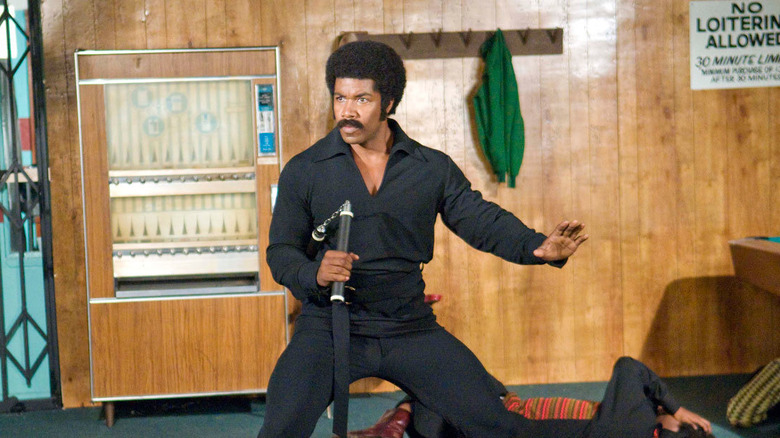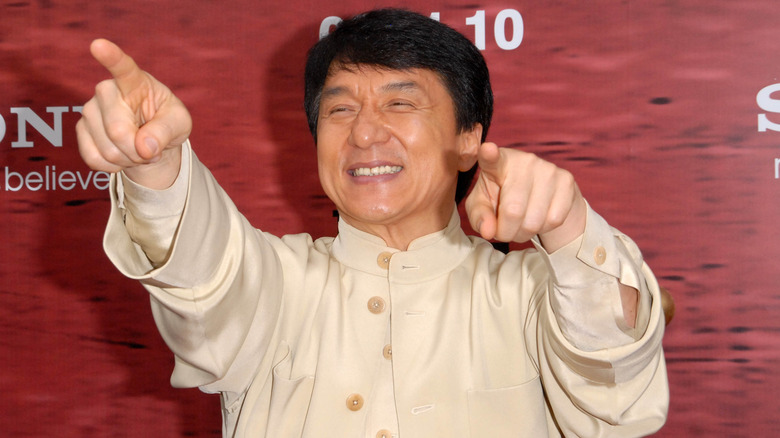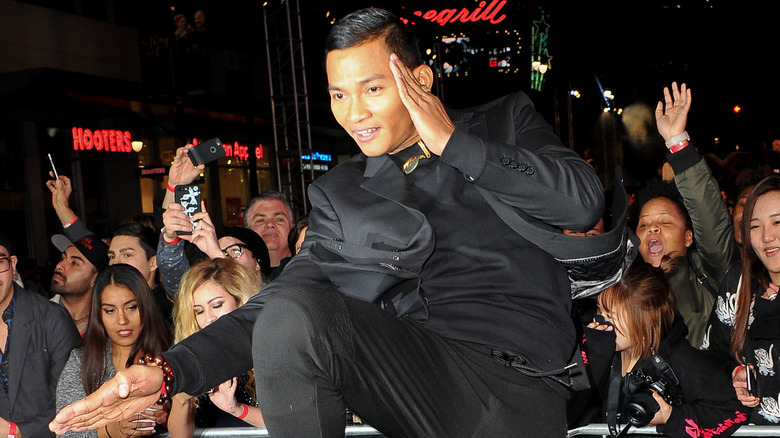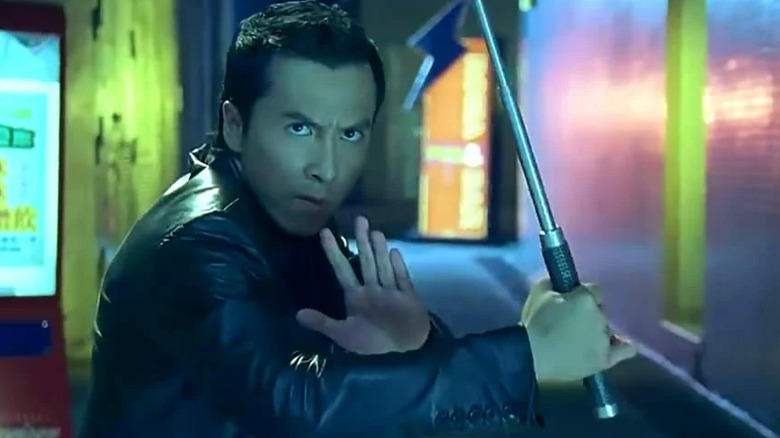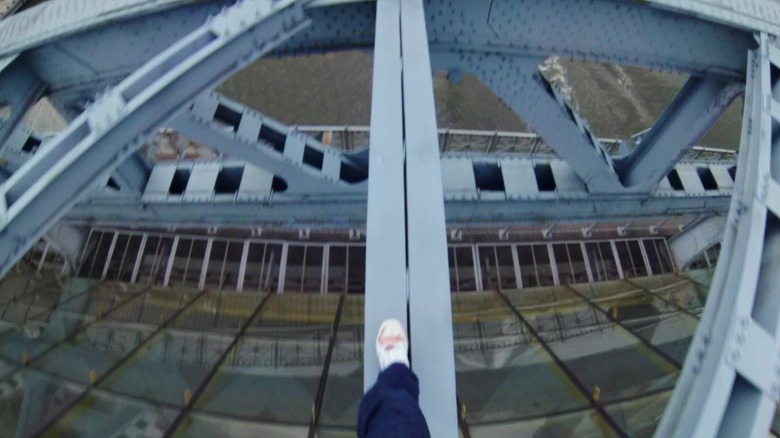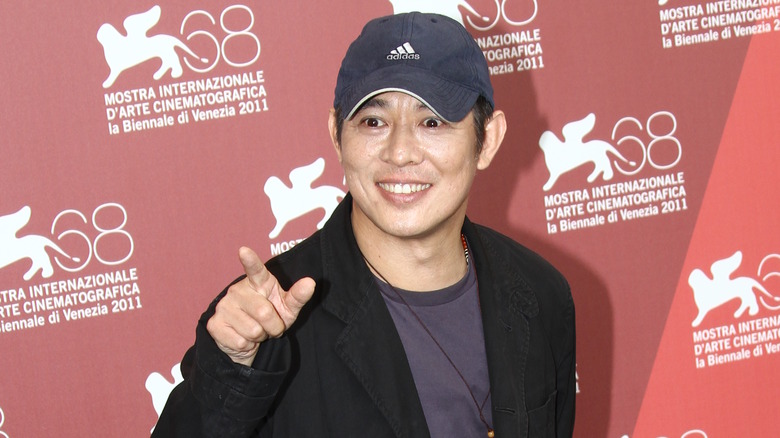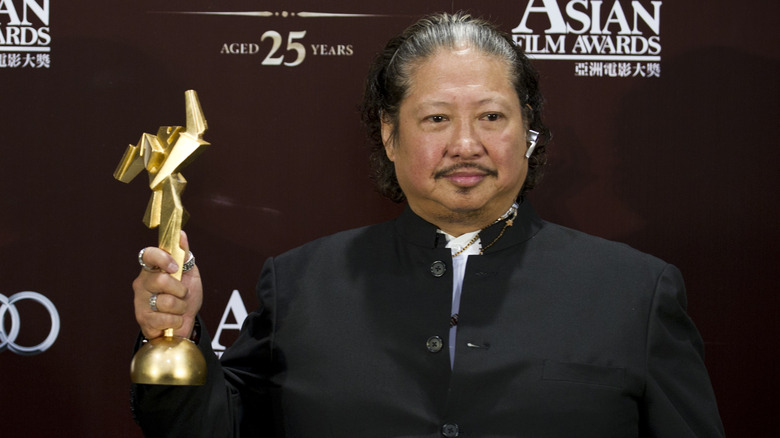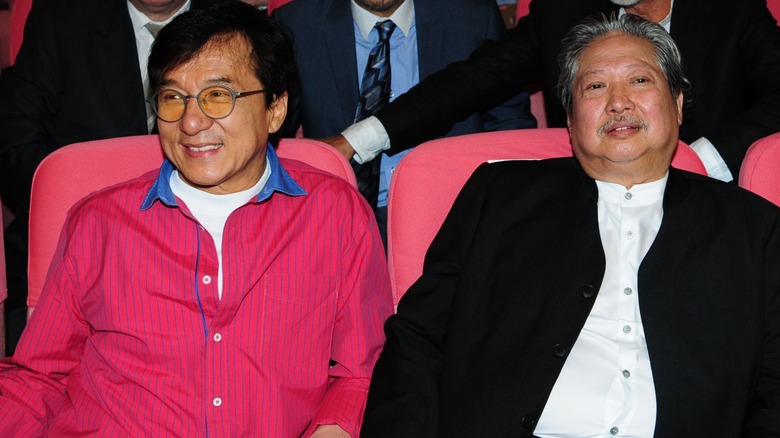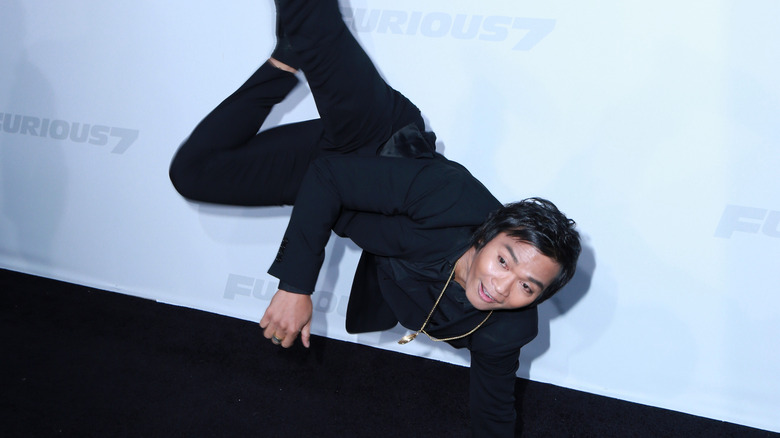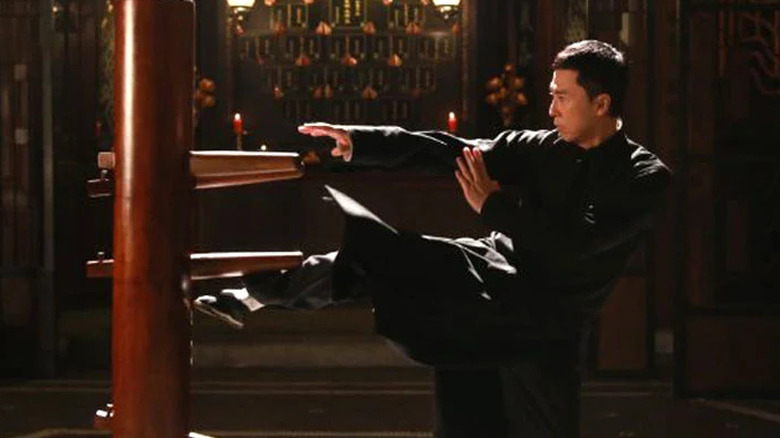Hidden Martial Arts Movie Details Almost No One Notices
Martial arts films hold the power to deliver some of the most thrilling moments in all of cinema. Action is sometimes looked down on, but fans of the genre know better than to downplay all of the time, energy, and pain that goes into making great fight sequences. There is a purity to the entertainment value of a brilliantly choreographed, staged, and performed action set piece.
There are plenty of bad action movies that get martial arts styles wrong because of poor choreography, actors who lack fighting ability, choppy editing, shaky camerawork, or a combination of the above. But when executed properly, these kinetic thrills require extreme coordination, commitment, and skill from all involved. Authentic martial arts films are made quite differently than films in other genres, and that specialized creation process offers up plenty of interesting details that often go overlooked. From filmmaking tactics that fly under the radar to behind-the-scenes stories involving the biggest names in kung fu filmmaking, these are some of the most fascinating details about the world of martial arts cinema.
The prop glass in Police Story is extra thick
"Police Story" is a 1985 kung fu cop movie starring, co-written, and co-directed by Jackie Chan. This undisputed masterpiece of the action genre finds Chan raising the bar for himself at every turn. The fights are more kinetic and detailed, the stunts are bigger and more dangerous, and even the glass is thicker.
When glass shatters on screen, it is often a breakaway prop made from a safe-to-use substance like sugar. When shooting "Police Story," Chan felt that the breakaway glass didn't look real enough. To fix this, he had the SPFX team make the prop glass twice as thick as normal. The results speak for themselves, as the glass truly does look more viscerally real than in most action movies. The only problem is, when you make breakaway glass extra thick, it stops being as safe and is more akin to real glass.
This double-thick glass led to many injuries on set. Some of the wounds you see on characters in "Police Story" are 100% real. This was particularly important, given just how much glass is broken in the film, especially in the big finale set piece in the shopping mall where at least one limb is bound to smash through a pane of glass in practically every shot. "Police Story" is quite possibly the glassiest action movie ever made, as evidenced by the crew calling the movie "Glass Story" instead of its actual title.
Michelle Yeoh could barely move while shooting Crouching Tiger, Hidden Dragon
"Crouching Tiger, Hidden Dragon" is an incredible piece of work in many regards, and its excellence only becomes even more impressive with the knowledge of how difficult the production was. Along with the difficulties of stars Chow Yun-Fat and Michelle Yeoh not speaking Mandarin and instead learning their dialogue phonetically, the set was also home to a debilitating injury.
Although director Ang Lee and editor Tim Squyres managed to hide it exceptionally well, Yeoh could barely move during the shoot. Shortly into production, she tore her ACL, required extensive surgery, and spent the rest of production wearing a leg brace. The star sustaining such a severe injury would be disastrous on any film shoot, let alone on an action movie that requires the star to participate in fight scenes and complex wirework.
Lee was forced to get creative to figure out how to shoot her scenes. Her close-ups were often shot with her atop a swivel stool that enabled her to move slightly. They had her get pushed in a wheelbarrow when her character had to run toward the camera. Clever camera angles and a stunt double were used for her big fight scene against Ziyi Zhang, though Yeoh still did as much as she could physically manage. When looking closely, you can tell that whenever Michelle Yeoh's face is visible, her lower body mostly remains stationary, and her face is always obscured for the more acrobatic shots where a stunt double had to take over.
Choreography from Legend of the Drunken Master was replicated in The World's End
British filmmaker Edgar Wright has always been an outspoken fan of the work of Jackie Chan, so his decision to reference one of his most iconic films makes perfect sense. For his 2013 sci-fi comedy "The World's End," Wright found himself dabbling in martial arts filmmaking. Though his actors were all pretty far away from being martial artists, the action in "The World's End" was much closer to a kung fu flick than the average British action movie.
During one of the film's many pub fights, Wright recreated a brief moment of choreography from Chan's seminal 1994 masterpiece "Legend of the Drunken Master." The subtle homage is cool enough on its own, but becomes even more clever when you realize the link between the two films, as both revolve around heavy drinking, fighting, and the struggles of addiction. Though Jackie Chan himself wasn't involved in "The World's End," there was one person on the crew who had collaborated extensively with him in the past.
The fights in "The World's End" were choreographed by acclaimed martial artist Bradley James Allen. As a stunt man, stunt double, fight choreographer, and actor, Allen worked on many films with Chan, from his English-language productions "Rush Hour 3" and "Shanghai Noon" to his Chinese-language productions "Who Am I?" and "New Police Story." Allen was a part of the official Jackie Chan Stunt Team and famously fought him one-on-one in 1999's "Gorgeous" as the film's main antagonist.
Donnie Yen is responsible for introducing MMA to Hong Kong action movies
Martial arts superstar Donnie Yen is not just one of the best action stars in the game, but also one of the most influential. The kung fu genre is one with a tendency to be hyper-focused on traditionalism. Many Hong Kong action stars embrace this, but Yen bucked trends by seeking to modernize action filmmaking through the incorporation of mixed martial arts aka MMA.
Before Yen, MMA was largely dismissed as being non-traditional and flying in the face of the ancient Chinese martial arts styles. Contrary to many of his peers, Yen pulled influence from fighting styles that originated all around the world, which included those employed in combat sports. Yen identifies his 2003 film "Twins Effect" — which he served as the action director for but did not act in — as the first time he began incorporating MMA into his choreography. He pushed this style further in 2005's "Kill Zone" by grappling with Sammo Hung in the film's final fight. The 2007 movie "Flash Point" became the purest showcase of MMA to hit the Hong Kong film scene and sent ripples through the industry. This broader and more modern fighting style helped Yen's movies stand out from his contemporaries. Though he faced some pushback at first, he eventually won most kung fu fans over, and others soon began incorporating MMA moves into their films as well.
Jackie Chan wears a camouflaged cast in Rumble in the Bronx
Even though he was already a legend in his home country, Jackie Chan tried and failed several times to become a Hollywood star before finding success. The film that finally put him on the map with English-speaking audiences was "Rumble in the Bronx" from 1995, though the film was actually shot in Vancouver instead of NYC, as evidenced by the mountains clearly visible in the background in multiple scenes.
During one of the film's comparatively simple stunts in which Chan jumps down from a bridge strut onto the deck of a hovercraft, he broke his foot upon landing. He was rushed to the hospital and his leg was put in a cast, but he still needed to finish the movie. The solution was to make a custom sock that fit over the cast and was designed to look like a sneaker, matching the real sneaker he wore on his other foot.
Chan shows off the cast in the blooper reel and, if you keep an eye out for it on a rewatch, it is easy to spot whenever one of Chan's feet suddenly gets bigger and chunkier than the other. But to the unsuspecting eye, the camouflaged cast does its job perfectly, enabling Chan to finish the movie without ruining a viewer's immersion.
The Raid 2 was supposed to come first
"The Raid: Redemption" set the action world ablaze when it was released in 2011, becoming arguably the Indonesian film with the widest international reach. "The Raid 2: Berandal" followed three years later, drastically expanding the scope and story ambitions. Surprisingly, "The Raid 2" was supposed to be made first, or rather, instead of the original "The Raid."
Welsh writer, director, editor, and co-choreographer Gareth Evans wrote the screenplay for "The Raid 2" first, though it had a different title back then. Evans came to learn that the script was far too expensive to make at that point in his career, but instead of giving up the project, he wrote a prequel. "The Raid: Redemption" was specifically conceived as a smaller, cheaper, and shorter microcosm of what Evans hoped to eventually be able to do in the sequel if the first movie was a hit. "The Raid" is almost an hour shorter than its eventual sequel and is contained almost entirely within a single location: A high-rise apartment building controlled by a drug kingpin. The first movie was made for around $1 million, while the sequel was made for about $4.5 million, which is still unbelievably cheap compared to Hollywood movies, especially considering the incredible action sequences in its 2.5-hour runtime.
The heroes kill off the same thugs repeatedly
If you have ever watched an action film with a massive body count and marveled at the sheer number of actors and stuntmen who get killed off on screen, you may have been falling for one of the oldest illusions of the action genre. A film might have a body count in the hundreds, but that doesn't really mean there are hundreds of performers biting the bullet on screen. Instead, actors and stunt performers are recycled and killed off multiple times. In most films where a thug is introduced and quickly killed off in the same scene, it is easy for them to slip by without a viewer remembering their face the next time they pop up in a different costume. In "The Raid," it is a bit easier to spot one of these recycled thugs than usual owing to the eye-catching hairdo that he sports as multiple different residents of the apartment building who all meet their maker by the end of the film.
In the commentary track for the first John Wick movie, Chad Stahelski revealed that the protocol at 87eleven Action Design is to have the stunt team all grow out their hair and facial hair as long as possible prior to shooting. After they die in their first action scene, they each cut and shave their hair down incrementally per thug they embody in order to make them harder to spot when they reappear.
Black Dynamite can't turn his head
Black Dynamite is a kung fu-filled Blaxploitation parody starring acclaimed martial artist Michael Jai White — except the plot thickens once you realize that White doesn't actually play Black Dynamite, at least not directly. Instead, he plays the fictional footballer-turned-Blaxploitation actor Ferrante Jones, who in turn plays Black Dynamite.
White's performance as an actor playing an actor playing a character is deceptively layered, especially considering how goofy and over-the-top the sense of humor is in "Black Dynamite." If you look closely, you may notice that Black Dynamite struggles to rotate his head throughout the film because part of the backstory of Ferrante Jones is that he was a football running back who broke his neck. That career-ending injury is what led to his career in '70s grindhouse films and is what prevents him from easily turning his head when he is playing Black Dynamite.
White again played Ferrante Jones playing another Blaxploitation character in the fake trailer for "The Outlaw Johnny Black." The film has been completed and but has yet to receive a wide release to the general public.
Many Chinese martial arts stars got their starts in opera
Chinese opera is different from the other forms of opera found all over the world. When you think of opera, you likely imagine the classical form of Italian opera where the art originated. But Chinese opera involves not just singing but fighting, acrobatics, swordplay, and all manner of impressive physical feats.
Because of the highly athletic nature of Chinese opera, the performers of the art form make prime candidates for the martial arts film industry. Action stars like Yuen Biao, Sammo Hung, and Jackie Chan all got their start in Chinese opera before transitioning their learned skillsets to filmmaking. This trio of martial arts legends starred in many films together as the Three Brothers or the Three Dragons, but their roots go much deeper. From the time they were children, they grew up together in the Peking opera school, known in English as the China Drama Academy. In his autobiography "Never Grow Up," Chan goes into great detail about how the relentless training and corporal punishment of the China Drama Academy was grueling to get through but also provided the foundation that led to all of their successes in the film industry. The musical side of Chinese opera also helps explain why so many Hong Kong martial artists lead dual careers as singers. Chan, along with stars like Andy Lau and Nicholas Tse, have all released albums alongside their film work.
Thai martial artists perform live stunt shows
One aspect of life as a screen action hero that is unique to martial artists from Thailand is their regular participation in live stunt shows. Thai movie stars like Tony Jaa of "Ong-Bak: The Thai Warrior" and "The Protector" fame and Jeeja Yanin of "Chocolate" and "Raging Phoenix" fame use live stunt showcases as an avenue to promote their movies.
They appear on talk shows and travel to theaters and other venues all around the world as part of their promotional tours, except instead of simply talking about their movies, they show off their physical abilities. These events can include gymnastics, acrobatics, all manner of physical feats, and even stage fights with other stunt performers. Sometimes, they perform excerpts of fight choreography directly from the movies they are promoting rather than simply showing a clip.
The athleticism on display from these performers is made all the more impressive considering that they are without the support of camera angles, editing, and special effects. It takes exceptionally skilled and disciplined physical performers to pull off these demonstrations live and without error, and the Thai film industry knows to capitalize on their abilities.
The first cut of Kill Zone had no action in it
The 2005 Wilson Yip film "Kill Zone" is best remembered today for its incredible and partly improvised alleyway fight between Donnie Yen and Jing Wu and, to a lesser extent, for the big finale nightclub fight between Yen and Sammo Hung. As wild as it sounds, neither of these two fights were in the first cut of the film. The movie was intended as a straight-up crime thriller that just happened to have martial artists in all of the major roles ... without actually putting their fighting abilities to use.
It was Donnie Yen who realized how disastrous the film's reception could be if they failed to deliver the action that he knew audiences would expect and crave. After principal photography had wrapped and the film was completely edited, Yen secured extra funding and gathered the cast and crew back together to shoot two fight scenes that slotted smoothly into the narrative. Yen directed the fights himself with Yip's approval. In the Hong Kong film industry, directorial duties are often divided between the director, who handles all of the dramatic scenes, and the action director, who takes over the film's fight scenes. Yen has only served as the main director a couple of times, but he frequently serves as the action director or fight choreographer for his own movies. "Kill Zone" marked the first collaboration between Yip and Yen, and they went on to work together in the same capacity several additional times, most notably on the internationally acclaimed "Ip Man" series.
Everything in Hardcore Henry was completely real and completely unsafe
The making of the first-person action movie "Hardcore Henry" was full of extreme risks, and a shocking amount of the danger in the film was completely real. Luckily, the stunt team was game to take big risks, with stuntman and actor Andrey Dementyev saying in a behind-the-scenes featurette, "That was the sacrifice of the art." Because of the film's first-person POV, it was impossible to fake hits, which meant the stunt team had to accept taking real strikes to the face. For a scene involving two characters sprinting across the top of a tall bridge, there was no way to set up wires or safety nets with their budget, so a fall could have meant certain death.
When they found themselves with an armored tank on set, director Ilya Naischuller spontaneously asked Dementyev if he was willing to let the tank roll over him, to which Dementyev agreed. One stuntman described being terrified during the filming of the bus scene when he had a flamethrower fired directly at him while he had no flame protection on whatsoever. For a shot where Henry is slammed face-first through a glass table, Dementyev was attached to a crane arm and rammed through the table for real. As if that wasn't dangerous enough, the glass didn't shatter on the first take, and he took the full impact to his face, which made the glass tabletop flip into the air in a way that could have decapitated him. All these risks led to an incredibly entertaining action movie, but the cost could have been tragic.
Jet Li nearly blinded Donnie Yen twice
Jet Li and Donnie Yen are two of the most legendary action stars to ever grace the silver screen. They have only acted together a handful of times throughout their careers, and their two biggest overlaps were in 1992's "Once Upon in Time in China II" and 2002's "Hero." These two films both had the legends fighting head-to-head with weapons and, in both instances, Li nearly blinded Yen.
As Yen explained in a retrospective of his career with GQ, he and Li are skilled enough that they were able to mix up the choreography and partially improvise their big fight with shafts of bamboo in "Once Upon a Time in China II." He described Li's slip-up by saying, "After about 30 takes, he missed ... He whacked me right on my eyebrow." Yen had blood gushing from his head and needed to go to the hospital for six stitches.
A decade later, Yen fought Li again, this time in the elegant sword vs. spear courtyard fight in "Hero." Just like before, Li accidentally missed one strike at the end of a complex shot after doing many, many takes and caught Yen in the face with his sword. Laughing it off, Yen said, "He whacked me on one side. 10 years later he whacked me on the other side." He went on to add, "Six stitches again, two times. Both sides close to my eyeballs, I could have been blind."
Some action stars hit their opponents for real
Most strikes in action movies are faked, usually through the forced perspective of camera angles. Accidents happen, and sometimes a real strike winds up in the finished movie. Barring accidental blows, there are some famous action stars that routinely hit their opponents for real and on purpose.
Partial-power hits to the body where protective pads can be hidden are one thing, but full-power strikes to the face or head are another story entirely. In the Thai action film industry, full-contact fighting is the norm. The majority of Tony Jaa's and Jeeja Yanin's elbows and knees land hard on their stuntmen opponents, leading to many injuries on set but making for spectacular fight scenes.
In the Hong Kong film industry, full-contact hits to the face are far rarer, though exceptions are made on occasion for special slow-motion close-up hits. Sammo Hung stands out in this regard and is known for hitting his opponents for real as hard as he can, and also encouraging the same from his stars when he is working as a director. Donnie Yen, Scott Adkins, Jean Claude Van Damme, and more have also struck their stuntmen for real on occasion, but only when their opponents volunteer to take the hit.
One action star who does it without permission is Steven Seagal. One martial artist who has publicly called Seagal out for this on more than one occasion is Michael Jai White, who told VladTV, "Steven Seagal hits the s**t out of people. That's a unique situation ... he's known for that."
Jackie Chan and Sammo Hung were friends but also rivals
Jackie Chan, Sammo Hung, and Yuen Biao are collectively known as the Three Brothers or the Three Dragons. This trio made numerous all-time great kung fu movies together and also led independent solo careers. Biao had plenty of great starring roles, but Chan and Hung were the bigger stars and found themselves competing for the position of the Hong Kong film industry's top martial arts movie star.
At 71 years old, Hung is two years older than Chan and was the first of the Three Brothers to find a solid foothold in the film industry. He helped the other two along since they all trained and grew up together within the China Drama Academy. When Chan began to grow more popular than Hung, a sense of competition was born. For a long time, the competitiveness between Chan and Hung was to the audience's benefit, as it drove them each to make better movies with faster fights, harder hits, and bigger stunts.
Eventually, their rivalry stopped being so friendly. The production of 1988's "Dragon's Forever," which starred all Three Dragons, marked the most contentious period between Chan and Hung. By the end of the decade, they largely went their separate ways, though they eventually reconnected when Hung directed Chan in "Mr. Nice Guy" and "The Medallion," and the two acted together in "Around the World in 80 Days."
Tony Jaa didn't know special effects were a thing
When Tony Jaa was a young boy growing up in Thailand, he was a huge fan of action movies. He wanted to emulate the fighting, stunts, and acrobatic feats pulled off in Hong Kong martial arts movies, but he didn't understand that what he was seeing on screen didn't necessarily reflect what the human body is typically capable of. Since he thought it was all physically possible and performed by those actors he watched in movies, Jaa pushed himself harder and harder until he could achieve the same results on his own.
In a mini-documentary on Jaa's skill showcased in "The Protector," martial arts film expert Bey Logan said that Jaa doesn't need special effects because "he's like a live-action special effect." He went on to explain that "Nobody ever told Tony Jaa that actors couldn't do that stuff ... he was in some remote village in Thailand watching all of these action pictures, then go out and train." Without realizing that the actors he idolized were using wires and special effects to pull off the amazing feats he saw on screen, Jaa somehow managed to replicate their moves using only the power of his body. As a result, Tony Jaa appears nearly superhuman in his movies and showcases a level of power and athleticism that often goes untapped. His best movies avoid using any special effects whatsoever and utilize that fact as a major selling point.
Donnie Yen didn't know wing chun before starting Ip Man
Though Donnie Yen has had many great roles throughout his career, the role that is most closely associated with him today is likely "Ip Man." The titular character is based on a real martial arts master, who was famously the man who taught Bruce Lee.
When bringing this real figure to the big screen, Yen found himself under intense scrutiny before the film had even been shot. Because he had spent the preceding few years going against tradition and pushing MMA-style fighting in his movies, there were many people out there who considered Yen an inappropriate choice to represent the traditional wing chun fighting style. To complicate the issue, wing chun was not one of the many fighting styles that Yen was an expert in at the time he was cast in the role. Yen had previously starred in a movie titled "Wing Chun" several years earlier, but it had failed to properly showcase its titular fighting style, and he was essentially learning from scratch when he began training for the first "Ip Man" movie. Rather than learning from any random wing chun practitioner, Yen was able to meet with Ip Chun, the son of the real-life Ip Man. Yen learned the basic moves of the form from him, such as the Sticky Hands technique, which Yen can be seen using frequently throughout the films.
